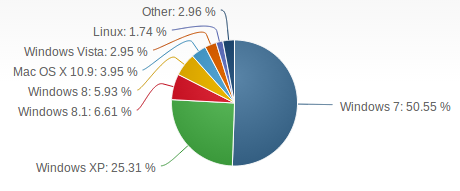Windows 8.x usage declines

Whether it indicates a hiccup or the first sign of a trend, Microsoft can't be happy that Net Applications found in its June 2014 operating system survey that Windows 8 and 8.1 dropped from May's 12.6 percent to 12.5 percent.

Despite the improvements in Windows 8.1, and its updates, Windows 8.x still hasn't proven popular. This is undoubtedly one reason Microsoft is pushing forward quickly with its release plans for Windows 9, Threshold.
Curiously, even though Windows 8.1 has been praised as being a significant improvement over Windows 8, Windows 8.1, at 6.6 percent, isn't much more popular than Windows 8 with its 5.9 percent.
Windows itself, with 91.5 percent, remains the dominant desktop operating system. Indeed, Windows 7, which moved up to 50.55 percent, saw its fourth straight month of gains.
Featured
Thus, business users seem to have been moving from the no longer supported Windows XP to Windows 7 instead of Windows 8. In March 2014, before XP support expired, XP had 27.7 percent of marketshare compared to Windows 7's 48.8 percent and Windows 8.x's combined 11.3 percent.
By June, XP dropped to 25.3 percent from March, a decline of 2.4 percent. Windows 8.x had gained a mere 1.2 percent during the same period compared to Windows 7's 1.75 percent growth.
Why is 2009's Windows 7 still gaining marketshare? In part, it's because some OEMs such as HP, started advertising the availability of Windows 7 systems. More simply, Windows 8, particularly with its Metro interface, has simply never attracted users.
As for the other desktop and laptop operating systems, Mac OS X 10.9 Mavericks is the most popular, single non-Windows operating system with 3.95 percent. While enormously popular in datacenters, clouds, mobile devices, and supercomputers, traditional desktop Linux distributions such as Fedora, Mint and Ubuntu, with a combined 1.7 percent, remain a non-contender on the PC.
Related Stories: